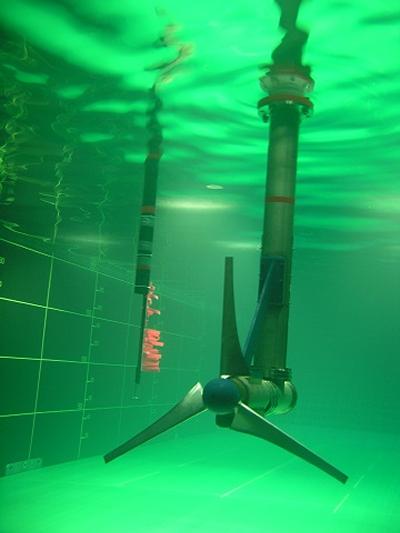
Tidal turbines (akin to underwater wind turbines) are at a stage of development where full-scale prototype devices have been deployed and tested in the seas surrounding the UK and other locations in the world. The next step is to deploy farms or arrays of multiple devices to demonstrate operability, cost reduction and the ability to generate electricity at a larger scale. In order to do this, device developers and funders of the technology must have confidence and assurances that these arrays of tidal turbines will perform as predicted.
This project addresses the issue providing data to enable industry to to validate dynamic (real time) array models for a range of things for example: optimised array design and layout; prediction of dynamic loadings and fatigue effects (rotors and blades) through inflow turbulence and device-device interactions and reliability or planning for operation and maintenance.
Dr Luke Myers has been part of the research team working on the project from the beginning. Read more below.
What the research does:
What our project has done is to:-
- Provide real, time -series data of loadings and power performance experienced by tidal turbines under realistic inflow conditions and when devices interact with one another (in array type configurations). At present there is little if any data on this (mostly average values or short time-scale experimental runs) which cannot sufficiently validate models. We will provide scale test data with all parameters required to use data sets for validation purposes
- Provide measured time-series data for larger multiple-row arrays than has been previously conducted
- Quantify so-called 'steady loads' and measure changes in performance over time through long-term testing of a scale device(s) in the sea
- Make project data available directly to relevant marine energy stakeholders in a timely manner
Key findings:
Results showed that the amount of turbulence (chaotic motion) in a tidal flow can significantly affect the power capture of a tidal turbine. Previous research has investigated what we call the turbulence intensity which is a sort of statistical property of how fast the local flow speed at a point is changing and by how much. Researchers varied this parameter in experimental tests and also varied the turbulent length scale which is the size of the swirls in the flow,referred to as eddies. We confirmed results of previous research that power capture is reduced as the turbulence intensity increases but we found that power can increase when the turbulent length scale increases.
Under test conditions (scaled from real tidal flows) we found an increase in power capture of 10% was possible between small and larger turbulent length scales. This increase is also dependent upon the type of rotor control of a tidal turbine. Like wind turbines it is envisaged that rotors will operate either at a fixed rotational speed or with variable rotational speeds. We were able to operate our instrumented scale turbine over a range of rotor control conditions. When larger eddies were present in the flow, a rotor operating at variable speed was better able to capture the energy contained in these eddies compared to a rotor operating at fixed speed or a narrow range of varying speeds. When the eddies were small, and even for a higher turbulence intensity, the difference in power capture between variable and fixed speed reduced such that they were almost comparable.
As part of this project we also developed a remotely monitored sea installation to complement our experimental work in existing indoor water channels. We bench marked performance between the 2 types of installation in an effort to better relate our indoor work to real sea conditions. This will give industry and other researchers more information and better understanding of all indoor laboratory facility testing. This test facility will soon be available for anyone to test scale tidal devices.
Where next?
This work will allow tidal device developers and operators to better predict power capture and structural loads depending upon the turbulence levels at any particular site. This has the potential to reduce installed costs and increase maintenance intervals. This work also indicates what type of rotor control strategy works best depending upon the turbulence parameters of a tidal flow. Our bench marking of indoor water channel facility tests and our real sea site, developed through this project, will give confidence to the sector that laboratory type- experiments can be related to real sea conditions and that the flow conditions in water channel facilities can be altered to better replicate specific tidal energy sites.
